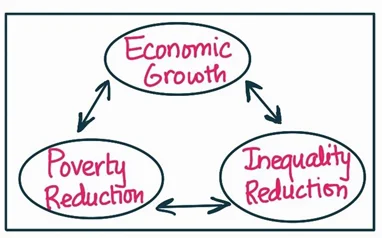Answer:
| Approach:
Introduction
- Introduce the challenges of poverty in India and the importance of poverty alleviation programs.
Body
- Divide the body into two main sections:
- Major poverty alleviation programs in India.
- Role of political will in the effectiveness of poverty alleviation programs.
Conclusion
- Write a relevant conclusion.
|
Introduction:
India, in its pursuit of inclusive growth, continues to be plagued by the longstanding challenges of poverty and inequality. While numerous poverty alleviation programs are in place, their effectiveness is often curtailed, partially due to insufficient political commitment. According to the World Bank data, by 2021, there had been a gradual decline in poverty rates in India. However, the COVID-19 pandemic has likely intensified these issues. This scenario underscores the urgent necessity for robust political commitment and systemic reforms to alleviate poverty.

Body:
Major poverty alleviation programs in India:
- Mahatma Gandhi National Rural Employment Guarantee Act (MGNREGA): Launched in 2006, MGNREGA aims to provide at least 100 days of wage employment per year to rural households seeking work. The program has had mixed results, with instances of successful implementation and notable impact on rural livelihoods, but also reports of corruption, fund leakage, and delays in wage payments.
- A report by the Accountability Initiative (AI) in 2020 highlighted that while the demand for work under MGNREGA had increased, especially due to the COVID-19 pandemic, there were considerable delays in wage payments. The report found that only 32% of the payments were made on time in the fiscal year 2019-20.
- Another study by the People’s Action for Employment Guarantee (PAEG) in 2021 pointed out that there had been a decline in the average days of employment provided per household under MGNREGA, falling short of the mandated 100 days. The study also highlighted that, despite the increased demand for work due to the pandemic, the central government’s allocation for MGNREGA in the budget for 2021-22 was lower than the revised estimate for the previous year.
- Public Distribution System (PDS): PDS provides subsidized food grains to vulnerable populations to combat hunger and malnutrition. While the program has contributed to food security for millions, it is also plagued by inefficiencies, corruption, and exclusion of deserving beneficiaries.
- According to the Economic Survey 2015-16, nearly 54% of the wheat, 48% of sugar, and 15% of rice allocated to the PDS was lost due to leakages. Moreover, about 36% of PDS kerosene was lost the same way.
- The Comptroller and Auditor General of India (CAG) report in 2016 pointed out that there was a significant diversion of PDS grains for open market sales.
- Furthermore, the “Global Food Policy Report 2020” by the International Food Policy Research Institute (IFPRI) also highlighted the persistent inefficiencies of the PDS in India.
- Pradhan Mantri Awas Yojana (PMAY): Launched in 2015, PMAY aims to provide affordable housing to the urban and rural poor. The program has made progress in the construction of affordable housing units, but the demand for housing far outstrips the supply.
- As per a report by the Comptroller and Auditor General of India (CAG) for the year ended March 2019, only 1.2 crore houses were completed under PMAY (Rural) against the target of 2.6 crores.
- In the case of PMAY (Urban), as of January 2021, out of the sanctioned 1.12 crore houses, only around 32.6 lakh houses have been completed, as per data from the Ministry of Housing and Urban Affairs. The report also pointed out delays in the completion of houses and in the release of central assistance.
Role of political will in the effectiveness of poverty alleviation programs:
- Implementation: Strong political will is essential for effective implementation, ensuring that programs reach their intended beneficiaries and achieve desired outcomes.
- For example, in case of Mahatma Gandhi National Rural Employment Guarantee Act (MGNREGA), strong political will is needed to ensure proper implementation, timely payment of wages, and effective monitoring of the program’s outcomes.
- Resource allocation: Political will is crucial for the allocation of adequate resources to poverty alleviation programs, as well as ensuring transparency and accountability in their utilization.
- For instance , in the case of Pradhan Mantri Jan Dhan Yojana (PMJDY), Political will is crucial in ensuring the allocation of resources, facilitating the opening of bank accounts, and promoting awareness among marginalized communities about the benefits of financial inclusion.
- Monitoring and evaluation: With political backing, programs can be effectively monitored and evaluated, enabling data-driven decision-making and improvements in program design and delivery.
- For example, National Rural Livelihood Mission (NRLM), focuses on empowering rural households by providing them with opportunities for self-employment and skill development. Political will plays a vital role in resource allocation, training and capacity building, and monitoring the progress of beneficiaries to ensure effective poverty reduction.
- Tackling corruption: Political will is required to address the corruption that often undermines the effectiveness of poverty alleviation programs and erodes public trust.
- For instance, Direct Benefit Transfer (DBT) is an initiative that aims to transfer government subsidies and welfare benefits directly to the bank accounts of beneficiaries, eliminating middlemen and reducing corruption. Political will is crucial for implementing the necessary infrastructure, ensuring accurate targeting of beneficiaries, and addressing potential challenges during the transition.
Conclusion:
Only with steadfast political commitment can these programs transition from mere showpieces to effective instruments for poverty reduction and social progress.
